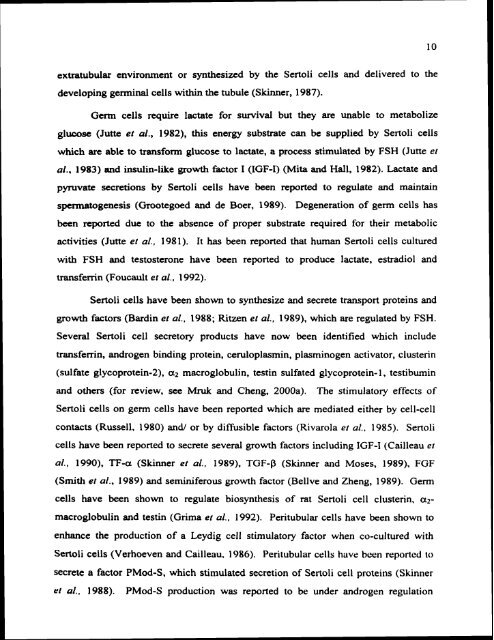ON TESTIS AND EPlDlDYMlS OF RATS - Pondicherry University ...
ON TESTIS AND EPlDlDYMlS OF RATS - Pondicherry University ...
ON TESTIS AND EPlDlDYMlS OF RATS - Pondicherry University ...
Create successful ePaper yourself
Turn your PDF publications into a flip-book with our unique Google optimized e-Paper software.
extratubular environment or synthesized by the Sertoli cells and delivered to the<br />
developing germinal cells within the tubule (Skinner, 1987).<br />
Germ cells require lactate for swival but they are unable to metabolize<br />
glucose (Jutte el al., 1982), this energy substrate can be supplied by Sertoli cells<br />
which are able to transform glucose to lactate, a process stimulated by FSH (June er<br />
al., 1983) and insulin-like growth factor I (IGF-I) (Mita and Hall, 1982). Lactate and<br />
pyruvate secretions by Sertoli cells have been reported to regulate and maintain<br />
spermatogenesis (Grootegoed and de Boer, 1989). Degeneration of germ cells has<br />
been reported due to the absence of proper substrate required for their metabolic<br />
activiries (June el al.. 1981). It has been reported that human Sertoli cells cultured<br />
with FSH and testosterone have been reported to produce lactate, estradiol and<br />
transfemn (Foucault el a[., 1992).<br />
Sertoli cells have been shown to synthesize and secrete transport proteins and<br />
growth factors (Bardin el d.. 1988; Ritzen el al.. 1989). which are regulated by FSH.<br />
Several Sertoli cell secretory products have now been identified which include<br />
transferrin, androgen binding protein, ceruioplasmin, plasminogen activator, clusterin<br />
(sulfate glycoprotein-2). a2 macroglobulin, testin sulfated glycoprotein-I, testiburnin<br />
and others (for review, see Mruk and Cheng, 2000a). The stimulatory effects of<br />
Sertoli cells on germ cells have been reported which are mediated either by cell-cell<br />
contacts (Russell, 1980) and! or by diffusible factors (Rivarola er a!.. 1985). Sertoli<br />
cells have been reported to secrete several growth factors including IGF-I (Cailleau el<br />
01.. 1990), TF-a (Skinner et al.. 1989). TGF-P (Skinner and Moses, 1989). FGF<br />
(Smith el al., 1989) and seminiferous growth factor (Bellve and Zheng, 1989). Germ<br />
cells have been shown to regulate biosynthesis of rat Sertoli cell clusterin. a:-<br />
macroglobulin and testin (Grima et al., 1992). Peritubular cells have been shown to<br />
enhance the production of a Leydig cell stimulatory factor when co-cultured with<br />
Senoli cells (Verhoeven and Cailleau. 1986). Peritubular cells have been reportcd 10<br />
secrete a factor PMod-S, which stimulated secretion of Sertoli cell proteins (Skinner<br />
el al., 1988). PMod-S production was reported to be under androgen regulation

















